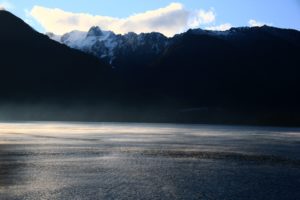The Enviroment
Our commitment as an industry is to provide the world with an excellent product. Our major challenges as a productive sector include striving for financial, environmental and social sustainability every day.
We are aware that the crystal clear waters of Chilean Patagonia represent our core asset,
therefore, Chilean salmon farming has strong legislation, regulations and environmental programs,
developed by the association’s member companies and by various authorities.
The entire production process has a number of mitigation measures, its environmental practices
are constantly improved, it is subject to strict inspections and it must comply with demanding
national and international standards.
The industry is advancing every day based on preventive rather than reactive environmental
management. It is supported by continual scientific research, it develops technology and
innovation, and it publishes its knowledge nationally and globally in both public and private
sectors
USE OF ANTIBIOTICS
Why does the salmon industry in Chile use antibiotics?
96% of the antibiotics used in Chilean salmon farming are applied during the fattening stage at sea. 92% of them are used to treat infection caused by the intracellular bacteria Piscirickettsia salmonis, an endemic pathogen exclusively found in Chilean salmon farming.

Antibiotics are directly used in Chile for therapeutic purposes, and not for prevention or as growth promoters. All the antibiotics used in Chilean salmon farms must be prescribed by a veterinarian, who must ensure that they are therapeutically required for fish welfare, and never used for prevention.
The antibiotics used by the Chilean aquaculture industry are strictly regulated by the Authority.
Furthermore, the antibiotics selected are not included in the list of drugs that are deemed critical for human consumption by the WHO. Their use strictly complies with international standards and World Organization for Animal Health recommendations that they are only used therapeutically and for the benefit of animal welfare. The antibiotics used are fully approved by our target markets. (For example: USA, Japan, China, etc).
Again, Chilean salmon does NOT contain traces of antibiotics, and does NOT constitute a risk to health. Therefore, we can confirm that Chilean salmon is free of antibiotics.
HARMFUL ALGAL BLOOMS
hile is also affected, as we experienced during 2016 in the Los Lagos Region, causing not only the death of marine fauna, but also a contraction in the local economy and unemployment.
We must learn to live with this phenomenon, and this requires a long-term vision, based on objective scientific information and working together with all those with marine based livelihoods.
Accordingly, Salmonchile’s Intesal monitors the magnitude of these phenomena using the FAN platform, which is online and available to everyone in the community. Similarly, companies have monitoring systems along the southern coast that tracks this phenomenon, and this information is shared with Sernapesca (National Fisheries and Aquaculture Service), health services and artisanal fishermen, to ensure that anyone potentially affected is promptly informed.
Favorable conditions for this phenomenon are increases in sea temperatures together with increases in the intensity of the sun. Therefore, algal blooms usually occur in the summer.
The industry’s preventive initiatives include designing a comprehensive strategy that provides more information on monitoring and prevention. For example, sampling was increased from 400 to 1,600 in one year, thus providing more accurate information to support decision-making. The entire purpose of Salmonchile’s Intesal has been to drive more effective public-private coordination, encourage research, and generate a greater understanding of algal blooms in Chile.
